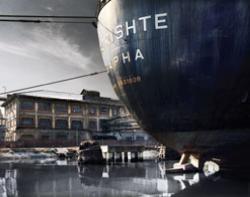interview by Simona Metalli and Alejandro Burgos Bernal
Q. The art of photography has been exemplary in creating an acute gaze on the things that lie before us all, since “if one does not try to express the inexpressible, nothing is lost” (L. Wittgenstein).
In the light of these remarks, how does your work express this acute gaze on the things that lie before our eyes, and in this case, the city of Venice?
A. I couldn’t really say how “acute” my gaze is. On the other hand, the gaze of photography can be extremely acute, just as it can come entirely from common knowledge.
Personally, I’ve learned not to take on theoretical problems that I can never solve. The most I can do –paraphrasing Eugenio Montale– is to identify what I wouldn’t want to be, meaning, what I wouldn’t want to see. When I do photography I’m aware that I drag along with me all the films I’ve seen, all the books I’ve read, the light effects in all the paintings I’ve always admired, and the comics that have inspired me. I think that my photography follows something that has been sedimenting over time in my head, at the bottom of my memories.
The instant that I see something I want to photograph, I have the sensation that, in reality, I’m rediscovering something that already belongs to me in some way. I also have to confess that I don’t concern myself with the issue of understanding the world through photography.
For me, it’s the exact opposite, if you will: it’s an escape, a transfiguration. Above all, it’s a mise en scène. If one of my images is able to evoke an emotion, it’s because it forces whoever looks at it to simply recognise the brazen force that a place possesses, the indescribable beauty of light.
Q. Looking at your work on Venice and thinking about photography as a mise en scène, Antonin Artaud comes to mind. In his "The Theatre and Its Double", he conceived of the mise en scène as a physical language, which is able to express a sort of electrifying visual harmony whose effectiveness acts as a whole and is communicated in a single glance...
What led you, then, to pick out Marghera as the right setting for rendering the brazen force of Venice?
A. You certainly can’t expect to use the “charm” of Marghera to express the perfect beauty of Venice. Marghera is a visual absurdity – a logical and aesthetic one, too. It’s a sort of topographic countermelody. As a Venetian, I’ve always felt attracted by its shrill nearness, by its difference. Just as the Lido was my first desert, Marghera was my Metropolis in its time, “Los Angeles, 2019”, my Marseilles, in pursuit of Jean Gabin. The setting – an unlikely one, for a number of reasons – where I could unearth the “apparitions” of my imagination. The set of a film noir, the gloomy light of a ghost ship, the crane that rises like a medieval siege tower. It’s a play of associations, of projections. For me, chaos and the marvellous start when visions superimpose on one another: from that moment on, all I care about is the evocative force of an atmosphere, the ambiguity of its suggestions.
Q. What you call evocative force, ambiguity of suggestions, play of associations reminds us... an interminable visionary decentring.
Is it legitimate to posit a movement in this “giving to sight”, that goes beyond the image, as a sort of specific image memory?
A. It’s simply that we never stop looking at the world around us. By looking, we try to truly see – we hope to understand. Probably, I love photography because simply by looking, freely, I achieve an awareness of things. Contemplating places makes me feel free and, at the same time, it forces me to remain a perpetual hostage of my own gaze, destined to memory’s mission. The circular motion of nostalgia starts here maybe, where images crowd together, get mixed up, regenerate themselves. In one sense, I’ve always sought to lose myself, invent a time machine for myself, a cinema. Vision in itself is a drug that deludes and disorients. I think this is what Noodles was thinking, in the famous opium den scene in Sergio Leone’s “Once Upon a Time in America”.
In the end, it’s a lifetime of dreams and fantasies that we have to reckon with, and we have to be able to smile at our memories.
from the exhibition catalogue Flashes on water, 2006
|
|
 |